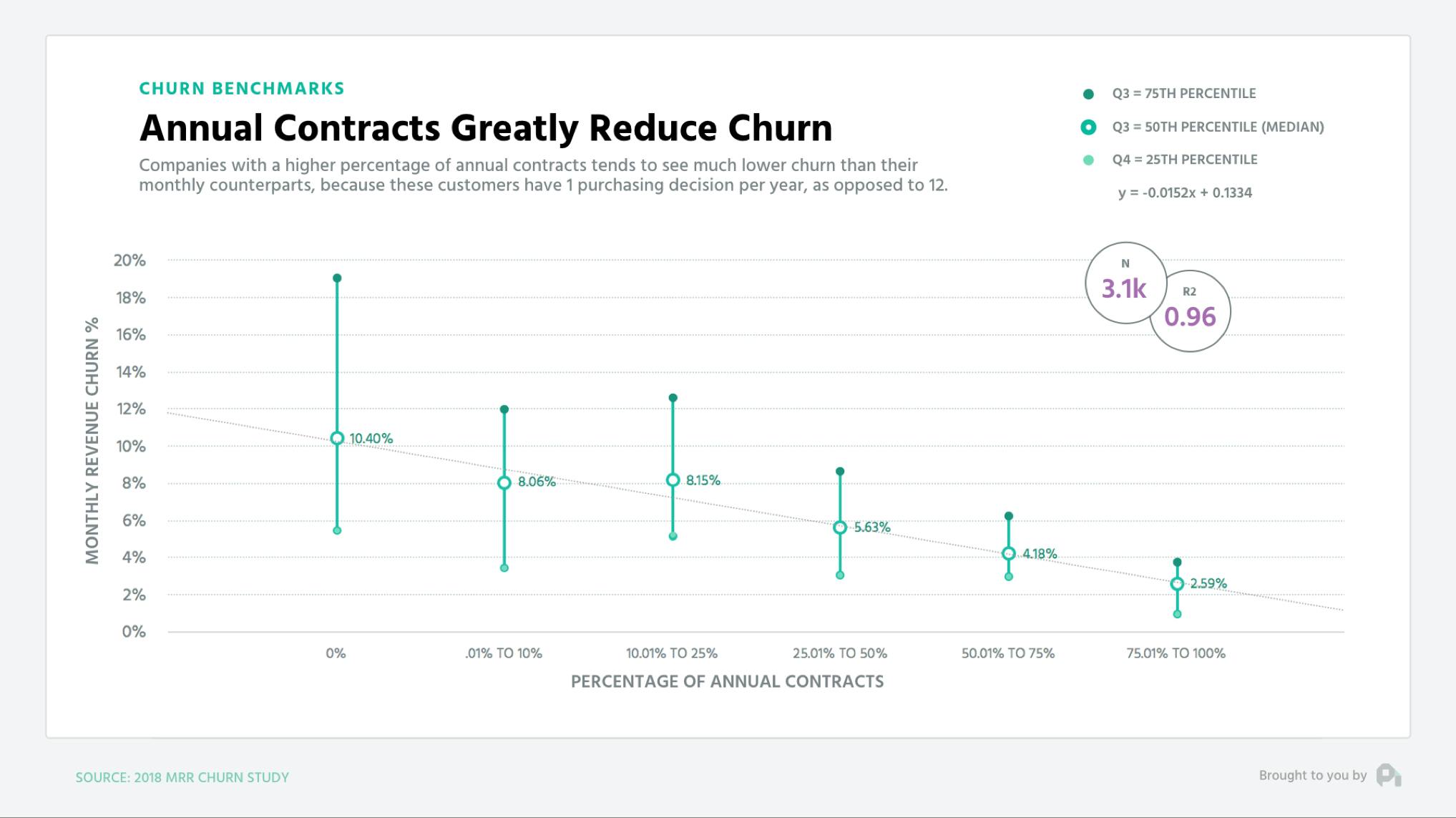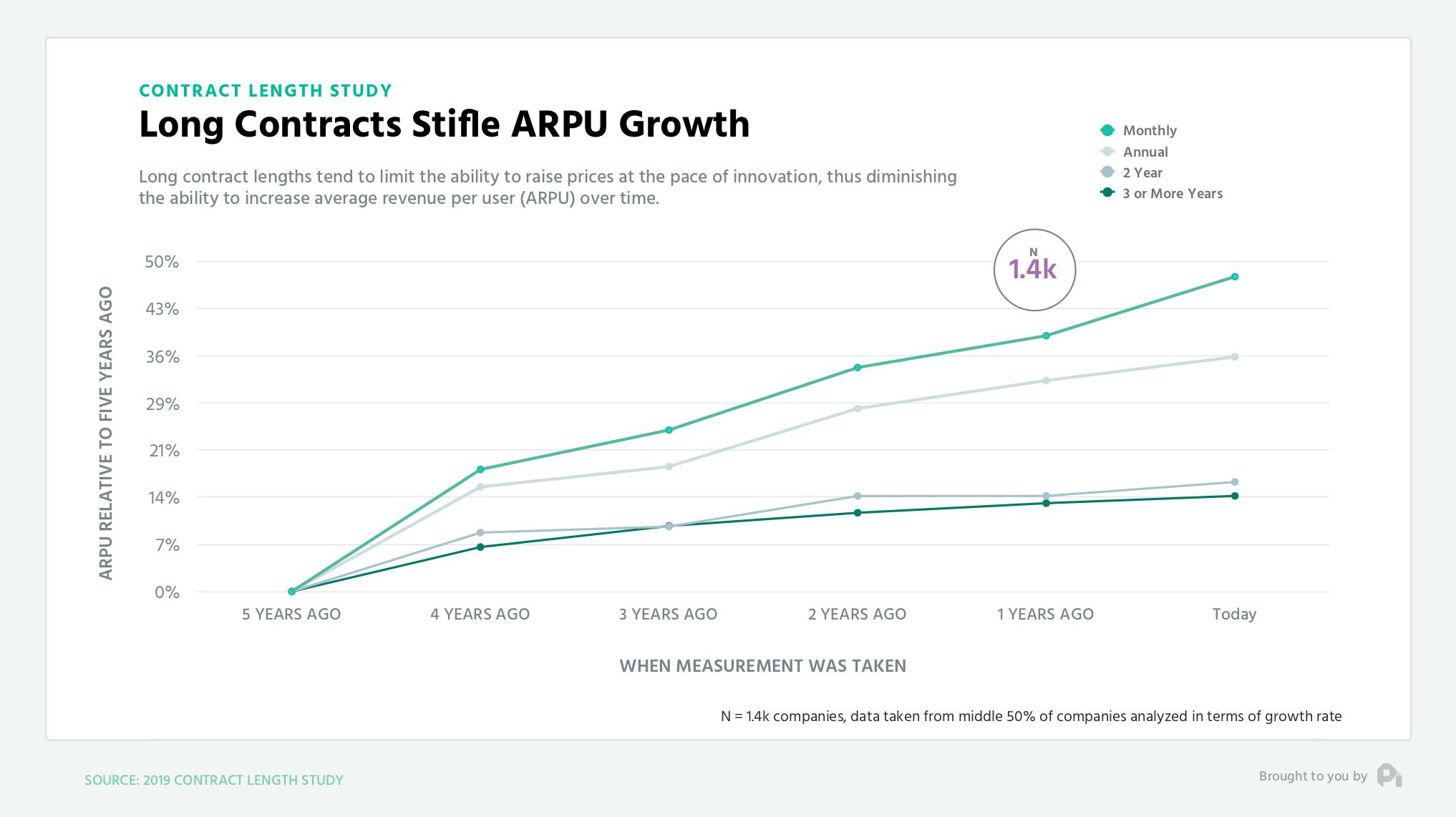
How does contract length impact ARPU and churn?
This episode might reference ProfitWell and ProfitWell Recur, which following the acquisition by Paddle is now Paddle Studios. Some information may be out of date.
Originally published: June 19, 2019
Relationships are where the beauty of the subscription economy truly shines. For the first time in the history of business, we have a revenue model where the relationship with the customer is baked right into how you make money. Interestingly enough though, we don’t have to test that relationship on a month to month basis – we can (and should) lock in a longer term. What’s the best term though? 1 year? 2 years?
As to not bury the lede - increasing the guaranteed subscription term absolutely lowers churn.
Regardless of ARPU, those companies with a higher percentage of annual contracts see significantly lower churn. This is because these customers have only one purchasing decision per year (albeit a larger one) whereas their monthly counterparts have 12 purchasing decisions per year. Note that the correlation is pretty strong here with those companies that have 100% annual contracts seeing 80% lower churn than those who only do monthly.
But first, if you like this kind of content and want to learn more, subscribe to get in the know when we release new episodes.


We don’t have enough data on multi-year contracts, but qualitatively we’ve seen the effects to be similar with one important exception. As you increase the term beyond 1 year, the reduction in customer attrition is minimal, meaning there isn’t much to be gained in terms of retention for 2+ year contracts.
There is much to be lost though with longer term contracts. While many people use two or more year contracts to guarantee they recover acquisition costs, the impact is you lose out on the ability to increase prices or your overall average revenue per user.

Note how those companies using monthly or annual contracts tend to have some fairly decent increases in ARPU over the years. The flexibility of these contracts ensures that as the product improves, the price can also improve. Remember, your price is the exchange rate on the value you’re providing. Those with longer term contracts tend to have fairly flat ARPU, mainly because so much focus is being put on the longer contract that these terms don’t provide a lot of flexibility.
Of course, a big lurking variable here is longer term contracts tend to be used for much larger deals, so what should you do?
Well, in most situations you should definitely optimize for a healthy dose of annual contracts. Axiomatically I would say that most companies out there should avoid contracts longer than a year, strictly because you want to be able to raise prices over time. Some industries won’t be able to avoid the long term contracts due to constraints from the cost of acquisition, but these folks should then make sure contract terms are flexible enough to warrant price increases, especially as the product improves
Want to learn more? Check out our recent episode on Founder Sleep and Growth and subscribe to the show to get new episodes.

1
00:00:00,320 --> 00:00:03,520
You've got the questions,
and we have the data.
2
00:00:03,520 --> 00:00:06,620
This is the ProfitWell Report.
3
00:00:08,945 --> 00:00:11,905
Hi, Neil. This is Vinish,
cofounder of White.
4
00:00:11,905 --> 00:00:17,380
My question is, how does the
contract plan impact ARPU and churn?
5
00:00:17,380 --> 00:00:18,480
Thanks.
6
00:00:18,500 --> 00:00:20,980
Welcome back, everyone.
Neil here from ProfitWell.
7
00:00:20,980 --> 00:00:23,380
Relationships are where the
beauty of the subscription
8
00:00:23,380 --> 00:00:25,275
economy truly shines.
9
00:00:25,275 --> 00:00:27,275
For the first time in
the history of business,
10
00:00:27,275 --> 00:00:29,675
we have a revenue model where
the relationship with the
11
00:00:29,675 --> 00:00:32,770
customer is baked right
into how we make money.
12
00:00:32,770 --> 00:00:34,130
Interestingly enough, though,
13
00:00:34,130 --> 00:00:37,410
we don't have to test our relationship
on a month to month basis.
14
00:00:37,410 --> 00:00:39,890
We can actually log
in a longer term.
15
00:00:39,890 --> 00:00:41,915
What's the best term
length, though? One year?
16
00:00:41,915 --> 00:00:42,955
Two years?
17
00:00:42,955 --> 00:00:44,075
To answer these questions,
18
00:00:44,075 --> 00:00:46,715
we looked at the data from over
three thousand subscription
19
00:00:46,715 --> 00:00:48,940
companies, and
here's what we found.
20
00:00:48,940 --> 00:00:50,300
As to not bury the lead,
21
00:00:50,300 --> 00:00:52,860
increasing the guaranteed term
of your contract with your
22
00:00:52,860 --> 00:00:55,020
customers absolutely
lowers churn.
23
00:00:55,020 --> 00:00:56,540
Regardless of ARPU,
24
00:00:56,540 --> 00:00:59,505
those companies with a higher
percentage of annual contracts
25
00:00:59,505 --> 00:01:01,345
see significantly lower churn.
26
00:01:01,345 --> 00:01:03,905
This is because these customers
have only one purchasing
27
00:01:03,905 --> 00:01:06,780
decision per year,
albeit a larger one,
28
00:01:06,780 --> 00:01:08,780
whereas their monthly
counterparts have twelve
29
00:01:08,780 --> 00:01:10,380
purchasing decisions per year.
30
00:01:10,380 --> 00:01:12,620
Note that the correlation is
pretty strong here with those
31
00:01:12,620 --> 00:01:15,825
companies that have one hundred
percent annual contracts,
32
00:01:15,825 --> 00:01:19,025
seeing eighty percent lower churn
than those who only do monthly.
33
00:01:19,025 --> 00:01:21,425
We don't have enough data
on multiyear contracts,
34
00:01:21,425 --> 00:01:22,625
but qualitatively,
35
00:01:22,625 --> 00:01:25,890
we've seen the effects to be similar
with one important exception.
36
00:01:25,890 --> 00:01:27,970
As you increase the
term beyond one year,
37
00:01:27,970 --> 00:01:29,730
the reduction in
churn is minimal,
38
00:01:29,730 --> 00:01:32,290
meaning there isn't much to be
gained in terms of retention
39
00:01:32,290 --> 00:01:34,135
for two plus year contracts.
40
00:01:34,135 --> 00:01:37,415
There is much to be lost though
with longer term contracts.
41
00:01:37,415 --> 00:01:39,975
While many people use two
or more year contracts to
42
00:01:39,975 --> 00:01:42,510
guarantee they recover
acquisition cost,
43
00:01:42,510 --> 00:01:45,470
the impact is you lose out on
the ability to increase prices
44
00:01:45,470 --> 00:01:47,950
on your overall average
revenue per user.
45
00:01:47,950 --> 00:01:50,910
Note how those companies using
monthly or annual contracts
46
00:01:50,910 --> 00:01:54,635
tend to have some fairly decent
increases in ARPU over the years.
47
00:01:54,635 --> 00:01:57,275
The flexibility of these
contracts ensures that as a
48
00:01:57,275 --> 00:02:00,075
product improves, the
price can also improve.
49
00:02:00,075 --> 00:02:03,480
Remember, your price range is
the exchange rate on the value
50
00:02:03,480 --> 00:02:04,600
you're providing.
51
00:02:04,600 --> 00:02:07,560
Those with longer term contracts
tend to have fairly flat ARPU,
52
00:02:07,560 --> 00:02:10,005
mainly because so much focus
is being put on the longer
53
00:02:10,005 --> 00:02:13,365
contract that those terms don't
provide a lot of flexibility.
54
00:02:13,365 --> 00:02:16,805
Of course, a big lurking variable
here is longer term contracts tend to
55
00:02:16,805 --> 00:02:18,770
be used for much larger deals.
56
00:02:18,770 --> 00:02:19,970
So what should you do?
57
00:02:19,970 --> 00:02:21,250
Well, in most situations,
58
00:02:21,250 --> 00:02:24,850
you should definitely optimize for
a healthy dose of annual contracts.
59
00:02:24,850 --> 00:02:27,955
Axiomatically, I would say that most
companies out there should avoid
60
00:02:27,955 --> 00:02:29,155
contracts longer than a year,
61
00:02:29,155 --> 00:02:32,355
certainly because you wanna be
able to raise prices over time.
62
00:02:32,355 --> 00:02:34,675
Some industries won't be
able to avoid the long term
63
00:02:34,675 --> 00:02:37,770
contracts due to constraints
from the cost of acquisition,
64
00:02:37,770 --> 00:02:40,250
but these folks should then
make sure contract terms are
65
00:02:40,250 --> 00:02:42,810
flexible enough to
warrant price increases,
66
00:02:42,810 --> 00:02:45,030
especially as the
product improves.
67
00:02:45,050 --> 00:02:46,495
Well, that's it for now.
68
00:02:46,495 --> 00:02:47,455
If you have any questions,
69
00:02:47,455 --> 00:02:49,855
send me an email or video
to neil at profit well dot com.
70
00:02:49,855 --> 00:02:52,815
And if you got value here or
any other week of the report,
71
00:02:52,815 --> 00:02:55,120
we'd love any shares on
Twitter and LinkedIn because that's how
72
00:02:55,120 --> 00:02:56,320
we know to keep going.
73
00:02:56,320 --> 00:02:58,860
Thanks, and I will
see you next week.
74
00:03:00,720 --> 00:03:03,175
This week's episode is
brought to you by PandaDoc.
75
00:03:03,175 --> 00:03:06,855
Empower your sales team to
create, send, track, and esign
76
00:03:06,855 --> 00:03:08,775
beautiful proposals and quotes.
77
00:03:08,775 --> 00:03:10,755
PandaDoc dot com.






